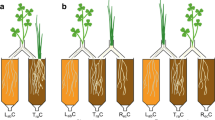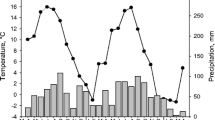Abstract
The overuse of classical N fertilisers contributes substantially to environmental degradation by pollution of groundwater by nitrates. This leaching of N in waters is also an economic flaw for farmers because only a part of the fertiliser is used by the plants. Here, systems involving mixtures of legumes and grasses represent a sustainable alternative because legumes can fix atmospheric N2 using symbiotic microbes. N transfer in those mixtures has been thoroughly investigated but little is known concerning the effect of N fertiliser on N transfer between N-fixing legumes and companion grasses. In white clover (Trifolium repens L.) — perennial ryegrass (Lolium perenne L.) associations, N is transferred mostly through rhizodeposition into the soil by clover followed by re-uptake by ryegrass. Rhizodeposition of N occurs through senescence and decomposition of legume tissue or through exudation of N compounds by living cells. Ammonium and amino acids are the main compounds exuded and their exudation is thought to occur by passive diffusion attributed to a concentration gradient from root to soil. In this study, we test the hypothesis that greater N transfer from clover to grass, as seen in N-rich soils or nutrient solutions, is due to greater N rhizodeposition brought about by higher ammonium and amino acid content of roots. The relations between N input, root N content, N net exudation and N transfer between legumes and grasses were investigated using 15N by growing white clover and perennial ryegrass with increasing N application in axenic microlysimeters or in pots. Ammonium and amino acid concentrations were measured in root tissues, in root bathing solutions and in soils. We found that mineral N application strongly reduced atmospheric N fixation by clover, from 3.0 to 0.9 mg per plant, and root amino acid content, from 164 to 49 nmoles per g dry weight, but had no effect on ammonium and amino acid concentrations in sterile exudates, showing for the first time that amino acid net exudation is independent of root content. In contrast, ammonium and amino acid concentrations in clover soils increased with N fixation, showing the link between N fixation and N rhizodeposition in soils. Nitrate application increased ryegrass root growth by 7–8 times, and transfer of N between clover and ryegrass (by 3 times). It is concluded that N fertiliser does not modify N exudation but decreases N fixation and ammonium rhizodeposition in soil by clover. N fertiliser increases N transfer between clover and ryegrass by increasing soil exploration by ryegrass and giving a better access to different available N sources, including the N compounds exuded from clover.
Similar content being viewed by others
References
Benizri E., Courtade A., Guckert A. (1995) Fate of two microorganisms in maize simulated rhizosphere under hydroponic and sterile conditions, Soil Biol. Biochem. 27, 71–77.
Brophy L.S., Heichel G.H. (1989) Nitrogen release from roots of alfalfa and soybean grown in sand culture, Plant Soil 116, 77–84.
Boller B.C., Nösberger J. (1987) Symbiotically fixed nitrogen from field grown white and red clover mixed with ryegrass at low level of 15N fertilization, Plant Soil 104, 219–226.
Deutsch B., Kahle P., Voss M. (2006) Assessing the source of nitrate pollution in water using stable N and O isotopes, Agron. Sustain. Dev. 26, 263–267.
Elgersma A., Schlepers H., Nassiri M. (2000) Interactions between perennial ryegrass (Lolium perenne L.) and white clover (Trifolium repens L.) under contrasting nitrogen availability: productivity, seasonal patterns of species composition, N2 fixation, N transfer and N recovery, Plant Soil 221, 281–299.
Garg N., Geetanjali (2007) Symbiotic nitrogen fixation in legume nodules: process and signaling. A review, Agron. Sustain. Dev. 27, 59–68.
Grayston S.J., Wang S., Campbell C.D., Edwards A.C. (1998) Selective influence of plant species on microbial diversity in the rhizosphere, Soil Biol. Biochem. 30, 369–378.
Hertenberger G., Zampach P., Bachmann G. (2002) Plant species affect the concentration of free sugars and free amino acids in different types of soil, J. Plant Nutr. Soil Sci. 165, 557–565.
Hertenberger G., Wanek W. (2004) Evaluation of methods to measure differential 15N labeling of soil and root N pools for studies of root exudation, Rapid Commun. Mass Spectrom. 18, 2415–2425.
Høgh-Jensen H., Schjoerring J.K. (1997) Interaction between white clover and ryegrass under contrasting nitrogen availability: N2 fixation, N fertilizer recovery, N transfer and water-use efficiency, Plant Soil 197, 187–199.
Høgh-Jensen H., Schjoerring J.K. (2001) Rhizodeposition of nitrogen by red clover, white clover and ryegrass leys, Soil Biol. Biochem. 33, 439–448.
Johansen A., Jensen E.S. (1996) Transfer of N and P from intact or decomposing roots of pea to barley inter connected by an arbuscular mycorrhizal fungus, Soil Biol. Biochem. 28, 73–81.
Jones D.L, Darrah P.R. (1994) Amino acid influx at the soil-root interface of Zea mays L. and its consequences in the rhizosphere, Plant Soil 163, 1–12.
Jones D.L., Owen A.G., Farrar J. (2002) Simple method to enable the high resolution determination of total free amino acids in soil solutions and soil extracts, Soil Biol. Biochem. 34, 1893–1902.
Jones D.L., Hodge A., Kuzyakov Y. (2004) Plant and mycorrizal regulation of rhizodeposition, New Phytol. 163, 459–480.
Kielland K. (1995) Landscape pattern of free amino acids in Artic tundra soils, Biogeochemistry 31, 85–98.
Ledgard S.F., Steele K.W. (1992) Biological nitrogen fixation in mixed legume-grass pastures, Plant Soil 141, 137–153.
Lesuffleur F., Paynel F., Bataillé M.P., Le Deunff E., Cliquet J.B. (2007) High proportions of glycine and serine in root exudates of six different species result from hight efflux rates, Plant Soil 294, 235–246.
Lipson D.A., Raab T.K., Schmidt S.K., Monson R.K. (1999) Variation in competitive abilities of plants and microbes for specific amino acids, Biol. Fert. Soils 29, 257–261.
Lipson D.A., Raab T.K., Schmidt S.K., Monson R.K. (2001) An empirical model of amino acid transformations in an alpine soil, Soil Biol. Biochem. 33, 189–198.
Murashige T., Skoog F. (1962) A revised medium for rapid growth and bio assays with tobacco tissue cultures, Physiol. Plant. 15, 473–497.
Näsholm T., Huss-Danell K., Högberg P. (2001) Uptake of glycine by field-grown wheat, New Phytol. 150, 59–63.
Nguyen C. (2003) Rhizodeposition of organic C by plants: mechanisms and control, Agronomie 23, 375–396.
Paynel F., Murray P.J., Cliquet J.B. (2001) Root exudates: a pathway for short-term N transfer from clover to ryegrass, Plant Soil 229, 235–243.
Paynel F., Cliquet J.B. (2003) N transfer from white clover to perennial ryegrass, via exudation of nitrogenous compounds, Agronomie 23, 503–510.
Phillips D.A., Fox T.C., King M.D., Bhuvaneswari T.V., Teuber L.R. (2004) Microbial products trigger amino acid exudation from plant roots, Plant Physiol. 136, 2887–2894.
Rogers J.B., Laidlaw A.S., Christie P. (2001) The role of arbuscular mycorrhizal fungi in the transfer of nutrients between white clover and perennial ryegrass, Chemosphere 42, 153–159.
Rroço E., Kosegarten H., Mengel K. (2002) Importance of plasmalemma H+-ATPase activity for N losses from intact roots of spring wheat (Triticum aestivum L.), Eur. J. Agron. 16, 187–196.
Shepherd T., Davies H.V. (1994) Pattern of short-term amino acid accumulation and loss in the root zone of liquid-cultured forage rape, Plant Soil 158, 99–109.
Soussana J.F., Hartwig U.A. (1996) The effect of elevated CO2 on symbiotic N2 fixation: a link between carbon and nitrogen cycles in grassland ecosystems, Plant Soil 187, 321–332.
Streeter T.C., Bol R., Bardgett R.D. (2000) Amino acids as a nitrogen source in temperate upland grasslands: the use of dual labelled (13C, 15N) glycine to test for direct uptake by dominant grasses, Rapid Commun. Mass Spectrum. 14, 1351–1355.
Svenning M.M., Juntilla O., Macduff J.H. (1996) Differential rates of inhibition of N2 fixation by sustained low concentrations of NH +4 and NO −3 in northern ecotypes of white clover (Trifolium repens L.), J. Exp. Bot. 47, 729–738.
Ta T.C., Faris M.A. (1987) Species variation in the fixation and transfer of nitrogen from legumes to associated grasses, Plant Soil 98, 265–274.
Ta T.C., MacDowall D.H., Faris M.A. (1986) Excretion of nitrogen assimilated from N2 fixed by nodulated roots of alfalfa (Medicago sativa), Can. J. Bot. 64, 2063–2067.
Thornton B., Robinson D. (2005) Uptake and assimilation of nitrogen from solutions containing multiple N sources, Plant Cell Environ. 28, 813–821.
Thomas B.D., Bowman W.D. (1998) Influence of N2-fixing Trifolium on plant species composition and biomass production in alpine tundra, Oecologia 115, 26–31.
Umar A.S., Iqbal M. (2007) Nitrate accumulation in plants, factors affecting the process, and human health implications. A review, Agron. Sustain. Dev. 27, 45–57.
Volk R.J. (1995) 15N assays of ammonium cycling in maize roots, in: INRA (Les Colloques, n∘ 70) (Ed.), Utilisation des isotopes stables pour l’étude du fonctionnement des plantes, Paris, France, pp. 175–182.
Weigelt A., Bol R., Bardgett R.D. (2005) Preferential uptake of soil nitrogen forms by grassland plant species, Oecologia 142, 627–635.
White J., Prell J., James E.K., Poole P. (2007) Nutrient sharing between symbionts, Plant Physiol. 144, 604–614.
Author information
Authors and Affiliations
Corresponding author
About this article
Cite this article
Paynel, F., Lesuffleur, F., Bigot, J. et al. A study of 15N transfer between legumes and grasses. Agron. Sustain. Dev. 28, 281–290 (2008). https://doi.org/10.1051/agro:2007061
Accepted:
Issue Date:
DOI: https://doi.org/10.1051/agro:2007061




